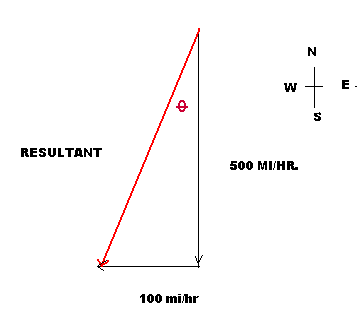What are Vectors and Scalars?
A scalar is a quantity that is completely specified by its magnitude and has no direction. A scalar can be described either dimensionless, or in terms of some physical quantity. Examples of scalars are: mass, volume, distance, energy, and time.
Scalar quantities can be manipulated by the laws of arithmetic applicable to natural numbers. For example if I add 20 grams of sugar to a recipe and then add 20 grams more the result is 40 grams of sugar in the recipe. If I buy a liter (1000ml) bottle of water and drink 250 ml, the amount left over is 750 ml.
A vector is a quantity that specifies both a magnitude and a direction. Such a quantity may be represented geometrically by an arrow of length proportional to its magnitude, pointing in the assigned direction. Examples of vectors are: displacement, velocity, acceleration, force and electric field. Vectors can be added in simple ways that scalars can. For example: A plane flies south at 500 miles/hour. A wind blows from the east at 100 miles/hour occurs. The resultant speed is not 600 miles/hour or 400 miles per hour.
 |
The resultant (red arrow) can be calculated using the Pythagorean Theorem R= sqrt (100^2 + 500^2) R= 509.9 mi/hr. The direction of the plane can be calculated using the cosine function. tan (Note: diagram is not drawn to scale) |
Force, Work and Energy
Speed, Velocity and Acceleration: What is the difference between speed and velocity? What is acceleration? Graphing Velocity and Acceleration. Testing your understanding.
Force: What is force? Measuring forces. Describing Forces. What does a force do? What is friction? Assessment Questions.
Vectors and Scalars: What is a vector quantity? Examples of Vectors. What is a Scalar Quantity? Examples of Scalars. Test your understanding of vectors and scalars.
Newtons Three Laws of Motion: See Newton's Three Laws in Latin and the English translation. Examples for each law are given..
Work, Energy and Power: Definitions for work, energy and power. Types of energy, calculating work, and power.
Difference between Mass and Weight: Great page for gifted and talented students! Some excellent challenging problems.
Gravity, Mass and Weight: Gravity, mass and weight in relation to the Solar System
Basic and Derived Units: Basic and derived units including , physical quantities, symbols for units of measure.
Mathematical Relationships in Science: See Lab 5, Acceleration.